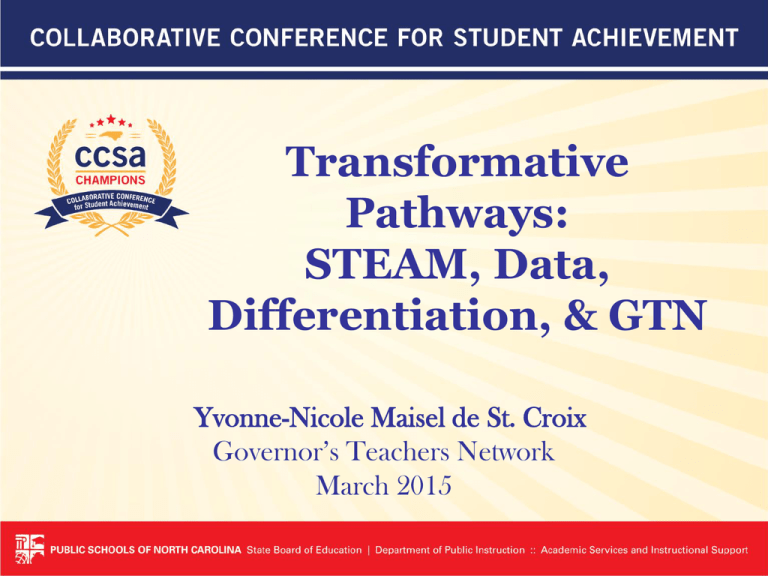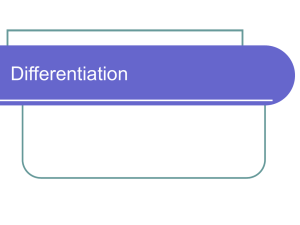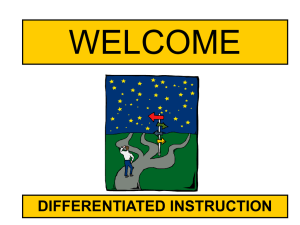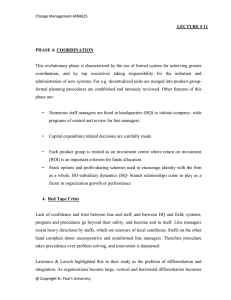Transformative Pathways: STEAM, Data, Differentiation, & GTN
advertisement

Transformative Pathways: STEAM, Data, Differentiation, & GTN Yvonne-Nicole Maisel de St. Croix Governor’s Teachers Network March 2015 Purpose of Session The purpose of this session is to support and motivate educators in the incorporation and implementation of effective and purposeful data-driven differentiation practices. We are the champions Championship, leadership Some of the verbiage it takes to become a champion: Research Action Garden Essential Questions 1.How is student data currently being utilized to direct differentiation in student instruction? 2.What data sets are most effective in regard to educators designing differentiated student instruction? Essential Questions 3. In what ways may person knowledge, task knowledge, and strategy knowledge be applied in the content area classroom to demonstrate effective delivery of data-driven instruction by educators? Essential Questions 4. Can methods of instructional delivery based on relevant data impact student learning in a positive, productive way? How may these results be measured? Action Research Plan Pre-assessment Meet with educators collectively to discuss term differentiation, evidence of differentiation, and obstacles to differentiation Educator Surveys How differentiation is currently being used to guide instruction How data is currently being used to guide instruction Educator Survey Example Variables regarding the use of data to driven differentiation to instruction include: Teacher-readiness Teacher-openness to differentiate curriculum Student-readiness Classroom management Administrative support Teacher collaboration Time management by educators Misconceptions regarding differentiation How do we know the readiness level of our educators? Data-driven Differentiation Session Topics Survey Data-driven instruction beginning of year evaluation - types of data being used to design instruction how data is gathered at the start of the year how data is interpreted by educators how data can be applied to differentiation in regard to objectives (per unit of study, yearlong) GTN Action Research Findings GTN Action Research Findings Objective 1 Participants will analyze how multiple data sets can be effectively used to strengthen classroom instruction. Formative Assessments and Summative Assessments These findings led me to consider: 1. The use of summative data should be integrated into the practice of flexible grouping. 2. Summative data should be evaluated and pre-assessments of student learning should be occurring to mitigate the time-consuming practice of re-teaching concepts. Objective 2 Participants will synthesize data into creative curriculum approaches. Crafting Purposeful, Differentiated Instruction Data should be employed and referenced in both the design and implementation of assessment, and those data sources should be reviewed and analyzed for validity and reliability. There must be purposeful design on the part of the educator that supports the practicality of assignments, but also a relevance that recognizes studentcentered, differentiated assessment practices. Data-driven instruction development Design Common Core and/ or state standards aligned lesson plan based on current instruction that has been modified to demonstrated data-driven differentiated practices Instructional Elements 1. the educator’s pre-conceived ideas of how the lesson will go upon delivery with differentiated modifications 2. relevant CCSS or state standards alignment 3. evidence of differentiated instruction 4. sequenced steps in the lesson plan 5. teacher generated materials and materials list 6. formative samples of student work 7. educator’s reflection of content delivery Ongoing Professional Development 1. 2. 3. 4. Formative and Summative Assessments Tiered Questioning Higher-level Questioning Skills Cluster grouping Objective 3 Participants will evaluate how STEAM integrates into classroom practices. Writing Heartbeat Sample Writing Heartbeat Survey Results For individual students, standardized test results can: • Initially identify various needs of exceptional students; • Pinpoint specific problems of learning and development; and, • Provide a useful supplement to the classroom teacher’s measures of academic progress. For individual students, standardized test results can: • Efficiently describe an individual’s learning abilities and levels of achievement; • Guide modifications or adaptions of instruction to meet individual needs; • Identify general areas of strengths and weaknesses; For groups of students, standardized test results can: •Provide a good indication of general ability levels prior to instruction; •Be used to establish reasonable classroom goals; For groups of students, standardized test results can: • Help shape the nature of instruction and supplemental instructional materials; • Identify areas of instructional strengths and weaknesses across classes, grade levels, or school buildings; and, • Provide one source of data about the effectiveness of instruction (Mertler, 2007). Authentically Facilitating Student Engagement 1. Give up absolute control of the lesson content Authentically Facilitating Student Engagement 2. Valuing student engagement over convenience Authentically Facilitating Student Engagement 3. Respecting indivudal student interests through flexibility, resourcefulness, sensitivity to student needs, and a deep understanding of content Authentically Facilitating Student Engagement 4. Admitting you do not have the market cornered on knowledge Authentically Facilitating Student Engagement 5. Develop healthy relationships with learners Source: Powell, M. (2013). 5 Ways to Make Your Classroom Student-Centered. Retrieved from http://www.edweek.org/tm/articles/2013/12/24/ctq_powell_strengths.html Action Research Conclusions Research supports professional development that: • Provides opportunities for active, hands-on learning. • Enables teachers to acquire new knowledge, apply it to practice, and reflect on results with colleagues. • Is collaborative and collegial. • Is intensive and sustained over time. Source: Darling-Hammond, L. & Richardson, N. (2009). Teacher Learning: What Matters? Educational Leadership, 66(5), 46-53 Educators can and should be the architects of their own professional development. That being said, educational leaders need to demonstrate transformational leadership by pre-assessing the individual and collective needs of an educational organization. Next Steps: Develop professional developments incorporating active, data-driven authentic learning experiences from local best practices Next Steps: Facilitate crosswalk conversations among grade levels involving multiple stakeholders to produce targeted objectives Next Steps: Encourage and incorporate educators from outside core content areas in crucial conversations regarding best differentiation practices and data usage Resources for principals: • Using Student Achievement Data to Support Instructional Decision Making • Principal's view of data driven instruction • Schoolwide Enrichment Thank you for your time and consideration! Yvonne de St. Croix Governor’s Teacher Network http://gtnpd160.ncdpi.wikispaces.net/District+or+State-Level+Presentation References Darling-Hammond, L. & Richardson, N. (2009). Teacher Learning: What Matters? Educational Leadership, 66(5), 46-53 Mertler, C. A. (2007). Interpreting standardized test scores. Thousand Oaks, CA: Sage Publishing. Powell, M. (2013). 5 Ways to Make Your Classroom StudentCentered. Retrieved from http://www.edweek.org/tm/articles/2013/12/24/ctq_powell_s trengths.html





